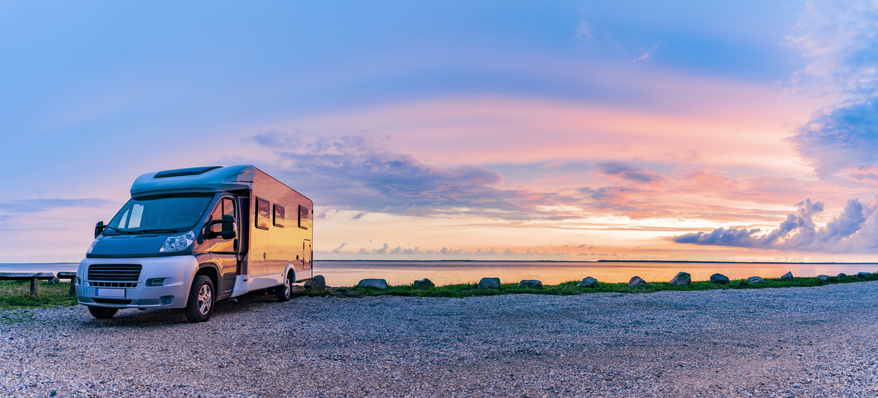Information provided by AAA’s Insurance Partner: Progressive
Of the different RV types, motorhomes are unique. They serve not only as our living space when traveling but also our means of mobility. Because of this, the maintenance for motorhomes is a bit more involved. You need to have two minds regarding maintenance: maintenance for the campsite, and maintenance for the road.
So let’s take a look at five key maintenance tasks you should complete. Some of these should be performed prior to every trip. Others might only need to be completed once a year or season. But by creating a list and a schedule, you stay on top of important maintenance and increase the longevity of your motorhome.
Inspection
Locate the generator and inspect for any damage prior to use. Include a visual and audio inspection of the exhaust system, looking for any damage to the exhaust pipe, listening for uncommon noises when it’s running, and ensuring the exhaust pipe is pointed away from the RV and clear of any obstacle that might prevent natural ventilation from the area.
Monthly exercise
The easiest maintenance you can perform on your generator is simply to run it once a month. This is often referred to as “exercising” your generator, and it’s a healthy practice that keeps all parts running smoothly.
Monthly exercise keeps all parts lubricated, eliminates damaging moisture buildup, and prevents carbon buildup. If you’re using your generator at the campsite each month, this will all happen automatically. If your motor home is going to be in storage, ensure that you run the generator at least once a month at 50% to 75% of its rated load. Refer to your manual to determine this.
Inspection
There are three different types of slide-outs, and each requires slightly different maintenance depending on the components. Prior to maintenance, complete a quick inspection of the main components of any slide-out:
- Inspect the gears on the side of the slide-out box for damage.
- Do not stretch cables to their full length; allow at least an inch of slack on the cord.
- Check for hydraulic leaks and inspect motor assembly fasteners.
Cleaning and conditioning
By keeping the rubber slide-out seals clean, you ensure no debris buildup causes damage when the slide-out is retracting and extending. Once you’ve cleaned the exposed rubber, use an appropriate slide-out conditioner that will prevent cracking or deterioration of the rubber.
Lubrication
Ensure all the moving pieces are properly lubricated—specifically the slide-out mechanism. This is the metal railing component that allows the unit to slide out. Use recommended lubrication and visually inspect the components as the slide-out extends.
Pre-trip inspection
Tires are one of the easier items to check off your list before departing on a trip. Ensure you complete an inspection like this before leaving each time.
- Tire pressure: Check each tire and ensure the PSI is at its recommended rating for your weight load.
- Tread check: You want no less than one-eighth of an inch of tread.
- Damage check: Are there any markings or damage to the sidewalls of your tires?
Storage
Just because you aren’t using your motorhome doesn’t mean you can let it sit. The tires need attention in storage, too.
Use tire covers during the winter months or when your motorhome is in storage to protect your tires and wheels from excess exposure. This will reduce the chances of important tire or wheel components rusting, as well as exposure to the rubber.
Tire pressure goes down over time while your wheels are in storage. And if left underinflated, the integrity of the tire could be compromised. Use your tire pressure gauge frequently and add air to the tires at least once a month in storage.
Rotation and alignment
At least once a year, have all your tires rotated and take your motorhome to a shop that can complete an alignment. This increases tire longevity and fuel efficiency and keeps your ride smooth.
Inspection
Complete a visual inspection of the exterior of your RV to identify wear and tear: Rust, peeling, warping, or chipping all indicate the need for repair or replacement. Inspect all sealed areas for cracks, gaps, or bubbles in the sealant.
Roof
If your RV is equipped with an attached ladder, your roof is likely safe to walk on, and you can clean and remove any branches or leaves prior to leaving. If not, complete these tasks on the side without stepping on the roof. Use water and a light solvent to clean the roof, especially if your RV is parked beneath a tree.
Inspect the rooftop air conditioning unit and clear any dirt or leaves that may be stuck in the filter or on the exterior of the unit.

Fluids and filters
Nothing will do more to protect your engine and prevent breakdowns than staying on top of recommended oil, filter, and fluid changes. Keep a regular schedule and a log of your mileage from when you last completed changes.
Batteries
Deep cycle batteries should be replaced every three to five years. With that knowledge, inspect batteries before every trip for any signs of corrosion at the connection points. When storing your RV, remove the batteries from your rig and store them in a proper environment.
Fresh, gray, and black water
Complete all necessary and recommended maintenance for your fresh, gray, and black water tanks, including recommended flushing and adding a deodorizer and necessary chemicals as needed.

Battery Service
Schedule a time for a AAA battery technician to come to your vehicle and test your battery, starter and alternator. We’ll even deliver a new battery, install it and take away your old one.
AAA Mobile App
With the AAA Mobile App, you’ll have all the most popular benefits of AAA Membership – right at your fingertips! Use the app to:
- Request roadside assistance
- Get directions
- Book a hotel or rental car
- Find the cheapest gas prices near you
AAA Automotive Discounts
Find everything you need to make your next adventure one to remember. From vehicle batteries and accessories to tires and even snacks for the road – you’ll find exclusive AAA member deals available all in one place!

